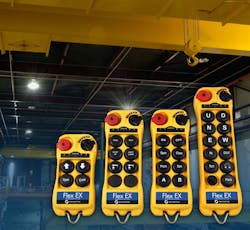Remote-controlled Lifting Can Boost Crane Safety
The use of radio-controlled cranes shows promise for enhancing lifting safety.
Tony Young, director at supply, installation, and repair specialist CP Automation, lays out the case.
Cab-controlled cranes have long dominated the industrial landscape, with the operator sitting in the crane, being guided by hand signals from a worker below. This advanced slightly to machines controlled by push-button pendants, involving a transmitter unit hanging from the crane by a cable being controlled by someone on the floor.
However, Young points out that this still tethers the operator to the crane and restricts movement.
“This is where radio crane control comes in,” Young says. “A handheld, cordless unit allows operators to remain on the facility floor, out of range of load swings and potentially dropped loads. It means that if lifting is taking place in hazardous areas, such as hot, noisy, or radioactive environments, operators are kept safe, well away from the area. This keeps the operator clear of the area and overhead load, providing significant health and safety benefits.”
The cordless flexibility means the operator is able to move to a much better location for visibility, rather than remaining limited to the field of view of the cab, or the length of the pendant cable. With this increased visibility, on foot and away from the load, the operator can clearly see a load shift and determine whether the load is properly rigged before continuing. They can also adapt quickly to any obstructions or changes in the path as the move is completed.
Equally, with the operator on foot, communication is greatly enhanced. The need for hand and voice signals between the operator and spotter is eliminated. Operators are closer to spotters, and can easily hear and act on what they are saying more quickly.
From an efficiency standpoint, floor operation may even eliminate the need for additional assistance on the floor completely. A single operator could also manage some of the operations with below-the-hook attachments such as magnets, grabs, or C-hooks. This reduces labor costs, according to Young.
“To help with this shift from cab-controlled cranes to safer, radio controlled systems, CP Automation is now supplying its customers with stock from Magnetek, a maker of crane and hoist systems,” Young says.
Cranes can be fitted with both CP Automation and Magnetek products as an integrated package, including power delivery systems, collision avoidance systems, radio remote-control transmitters, motor gearboxes, fail-safe brakes, and variable frequency drives. “Together, these products allow cranes to move heavy structures with sufficient power, control and intelligence, as well as increasing safety with remote control,” Young says.
"The partnership brings together the right set of products to support the rapid growth of the crane industry at present," says Andy Swann, business development manager, EMEA, at Magnetek. "Together we can provide a customizable, engineered system to match the most demanding of specifications, ensuring reduced load sway and load drops.
"We are seeing more and more crane OEMs moving away from in-cab operators and opting for radio remote control, whereby the operator is at a safe distance away from heavy loads,” Swann says.
“This means much more aggressive materials can be handled during a project, and the operator is kept at a safe distance, controlling the crane from afar."
